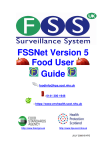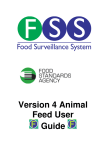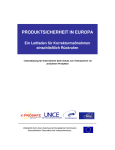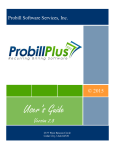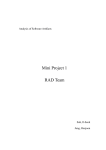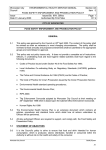Download FSSNet Version 5 Animal Feed User Guide
Transcript
FSSNet Version 5 Animal Feed User Guide : [email protected] : 0141 300 1946 : https://www.envhealth.scot.nhs.uk http://www.food.gov.uk http://www.hps.scot.nhs.uk July 2008 © HPS FSS Version: 5 2 USING THE FOOD SURVEILLANCE SYSTEM .............................................................. 4 Starting the application.............................................................................................. 4 MAIN SCREEN....................................................................................................................... 6 New Animal Feed sample ......................................................................................... 8 FEED PREMISES FIELD ORDER – IMPORTING PREMISES INTO FSS UK ADMINISTRATION GUIDANCE GUIDANCE......................................................................................... 10 ENFORCEMENT (ANIMAL FEED).................................................................................. 12 SURVEILLANCE (ANIMAL FEED) ................................................................................. 13 LABELLING (ANIMAL FEED) ......................................................................................... 14 CATEGORY TREE .............................................................................................................. 16 PACKAGING (ANIMAL FEED) ........................................................................................ 18 ANALYSIS (ANIMAL FEED)............................................................................................. 21 Durability Date......................................................................................................... 27 Code of Practice...................................................................................................... 27 Sample Templates .................................................................................................. 28 New Sample from template ..................................................................................... 31 Browse Samples ..................................................................................................... 32 Duplicate Sample .................................................................................................... 34 Export ..................................................................................................................... 34 PRINT LABEL ...................................................................................................................... 40 EXPORTED SAMPLES....................................................................................................... 41 Re Export ................................................................................................................ 41 IMPORT SAMPLES............................................................................................................. 42 Import Complete...................................................................................................... 44 Browse Complete Samples ..................................................................................... 45 Grouping Data......................................................................................................... 47 Full Details .............................................................................................................. 48 EXPORT TO XML ............................................................................................................... 49 Encrypted File Viewer ............................................................................................. 50 APPENDIX B: FEED DEFINITIONS ................................................................................ 53 Durability Date......................................................................................................... 53 APPENDIX C: HPS CONTACTS ....................................................................................... 53 HPS System Administrator ...................................................................................... 53 HPS Environmental Health Consultants .................................................................. 53 Postal Address ........................................................................................................ 54 APPENDIX C ........................................................................................................................ 55 Version Changes..................................................................................................... 55 3 USING THE FOOD SURVEILLANCE SYSTEM Starting the application To open the application double click the FSS icon on your desktop After running the program you will see the following security login screen. You will need to enter a valid Username and Password to continue running the application, otherwise the following warning message will be displayed. 4 After entering a valid User name and Password, you will see the application introduction screen. Once this screen appears you can either enter into the Food or Animal Feed Module using the radio select buttons. (the application remembers your choice so you do not have to keep selecting) In your case you select Animal Feed. Select either Live or Training to enter the main screen. The Live connection is used when inputting real data into the system. The Training connection can be used when entering dummy data for training other colleagues and for users to familiarise themselves with the system, then click OK. On this screen you will find some useful links to the FSS website, general enquiries email address, HPS website and a link to download video help. 5 Main Screen The Main screen is shown below Menus can be accessed from the top of the screen and clicking on the following buttons can access common functions. These can also be accessed in the File menu. New Sample Used to enter a new sample into the system Browse Samples Used to view samples that are in the system Sample Templates Used to View/Edit/Create sample template Import Samples Used to import samples with results into the System Exported Batches Used to re export samples and view batch detail 6 Shortcut Keys & Handy Tips The application follows standard Windows design concepts. [TAB] Moves forward from the current control to the next in the tab order [SHIFT][TAB] Moves back to the previously selected control [CTRL][TAB] Moves forward to the next data-entry screen [F2] Close currently open form [F4] Open a lookup dialog for the selected field [F5] New Record [F6] Edit selected record [F7] Save with validation to record being edited / inserted [F8] Save without validation to record being edited / inserted [F9] Previous data-entry screen [F10] Next data-entry screen The data-entry screens can be completed in any order. Press F9 and F10 to move from one data-entry screen to the next (or use mouse button to click data-entry screen tabs) All drop down/reference fields are identified by the Use the mouse to click on this drop down field or press the ENTER key Use the tab key ( ) to move through all data-entry fields 7 New Animal Feed sample Accessed by clicking on the New (Animal Feed) button from the Main Screen. Administration (Animal Feed) Micro - microbiological sampling is undertaken to ascertain the microbiological quality of feed and to determine the possible presence or absence of harmful microorganisms in feed. There are currently no microbiological standards set in feeding stuffs legislation for which the FSA act as the central competent body. Chemical - feed samples submitted for chemical sampling may undergo specific analyses such as for contamination, presence of additives, compliance with nutritional standards and National ref - unique sample reference number allocated by the FSS application. • Sample number – this is the number by which the sample can be identified by the Local Authority. 8 • Office - if your organisation has a number of offices branches in different locations, names for each of the offices can be added to, then selected from, the drop down list • Sample Officer - if your organisation has a number of officers taking samples, names for each of the officers can be added to, then selected from, the drop down list • Sample date - date that the sample was taken. The date can be selected by clicking on the tab to reveal the calendar • Time - time that the sample was taken. The time defaults to the current time but can be changed using the up / down arrows provided • Business ID - this is the unique identifying code of the business that is listed in your premises database (e.g. APP; CAPS etc). • Premises name - the name that the business from which the sample was taken is trading under. This information will usually be imported from your premises database (e.g. APP; CAPS etc). • Address - the address of the premises from which the sample was taken. This information will usually be imported from your premises database (e.g. APP; CAPS etc). • Post code - the postcode of the premises from which the sample was taken. This information will usually be imported from your premises database (e.g. APP; CAPS etc). • Feed risk category - the category in which the business was rated at the last food safety primary inspection. This information will usually be imported from your premises database (e.g. APP; CAPS etc). • Premises type – sub category into which the premises from which the sample was taken should be placed. These premises sub-categories agree with the FSA return (i.e. Manufacturer of compound feeds). • Purchase cost - the amount paid for the sample (if appropriate). Feed samples taken formally are normally taken from a batch consisting of more than 6Kg and taken from the place of packing/manufacture. You should follow your own authority’s policy with regard to payment for feed samples. 9 Animal Feed Premises Feed premises field order – Importing premises into FSS UK Administration guidance BusinessID PremiseName Address1 Address2 Address3 Address4 PostCode Feed Risk Category PremiseType Code Registration number Feed Risk Category: H (High) M (Medium) L (Low) Premises Type Code: K (Producers of feed materials) L (Stores of feed materials) M (Manufacturers of compound feed stuffs) N (Importers and representatives of establishments in third countries) O (Intermediaries, distributors and retailers) P (Manufacturers of additives and premixtures) Q (Animal farms) R (Other feed businesses) e.g. 11402,One Stop,,110 South Road,Taunton,Somerset,TA1 3BP,H,K,123245 1691,One Stop,,126 Wordsworth Drive,Taunton,Somerset,TA1 2HJ,M,L,M 28940,Thorntons,,21 Old Market Centre,Taunton,Somerset,TA1 2AT,L,M,12536 19549,Ireson's,,2a St. James Street,Taunton,Somerset,TA1 1JH,H,L,34776 10 To import this file into FSSNet click on File Import Animal feeds Premises Browse to the file and select Load Records Once the status bar is complete click on close. N.B. There is an option to remove all current records if you want to import a new batch, tick the check box to do this. If you leave the box unchecked then only new records will be added and the current records updated. 11 Enforcement (Animal Feed) Click on the Reason tab next to Admin at the top to access this screen. Select Enforcement/Investigation by clicking on it and checking the radio button. Reason for taking Sample: Enforcement / Investigation or Surveillance / Monitoring - reason why the sample has been taken in the first instance; enforcement/ investigation would cover, for example; routine or complaint, whereas surveillance / monitoring would cover survey or project samples. • Sample Type - formal / informal. These descriptors will suit whether the sample is; routine, complaint, survey or other. • Follow up sample - if this sample was taken following on from a preceding sample (e.g. after the first sample failed) • Index sample number – this is the number relating to the first sample taken, in order that preceding samples can be linked to this 12 Surveillance (Animal Feed) Click on the Reason tab next to the Admin tab at the top to access this window. Select Surveillance/Monitoring by clicking on it and checking the radio button. Surveillance / monitoring • Sample was taken as part of a survey – this applies where a number of samples are all taken for a specific survey purpose (e.g. a set time period during which monitoring of a specific product is undertaken). • Survey body – the name of the body or organisation that is instigating / coordinating the survey e.g. Food Standards Agency etc. 13 • Survey ref - this reference number allows all samples forming part of the survey to be linked. The first part of the survey number will normally be provided by the ‘Survey body’ (see above) to show that the sample forms part of the wider survey, with an option to add further identifying numbers for each sample if required (to allow identification of each unique sample forming part of the larger survey). Notes: • Formal – formal samples are taken in the manner as prescribed in The Feeding Stuffs (Sampling and Analysis) Regulations 1999 and submitted to an accredited laboratory. N.B. Formal samples submitted to the agriculture analyst must be accompanied by a statement to the effect that the sample was taken in the prescribed manner in accordance with the legislation if the officer intends to take legal action. • Informal – informal samples, are samples which have not been taken in accordance with the Sampling and Analysis regulations. They are also however submitted to an accredited laboratory. They do not require an accompanying statement. Labelling (Animal Feed) Click on the Labelling tab next to the Reason tab at the top to access this window. 14 Feed Name the name that the product is sold under (e.g. Pedigree Chum) Feed Description a basic description of the type of feed sampled. Where there is a name laid down by law this must be used. In most instances, the feed type will be one of those prescribed by law. For example, a Complimentary Feed. Animal Species The type of animal species the feed has been produced for in conjunction with the list contained in the Feeding Stuffs Regulations. This list is provided via the drop-down menu. Category Click on the icon and select a feed category from the codes provided on category tree feed types are categorised in terms of pre-populated categories in the ‘category tree’. Selecting the ‘category tree’ button on the right of the ‘category’ label allows the user to select from the populated 15 list (e.g. Compound Feed). Clicking on one of the item headers, you will see that there are subcategories under each main heading (e.g. Complimentary Feed). These can be used to populate the ‘sub-categories’ lists below Sub Category This will populate with feed category once selected in category tree Additional Product Information This allows the officer to enter free text. Statutory Statement information – information that is prescribed by feed legislation which must accompany the feed at the point of its final destination in the supply chain (i.e. the product label on pre-packed feed or the delivery docket on feed delivered loose from bulk). Business type business types can either be entered free text or via the drop-down menu provided (i.e. Distributor). a dedicated number allocated to the feed business operator by the local authority in accordance with the Feed Hygiene Regulation. Manuf. approval/reg. no Business name- Enter details from label on feed or select to pull in the address details from the Admin tab to save time. address (Label) enter importer details if appropriate. If the sample has not been sampled at the point of importation and the name of the Importer is contained on the product label, enter this information at this point. Importer (if appropriate) Country of Origin If the Country that the food originated from is available from the product label, select the country form the drop-down menu. Category Tree 16 You can use the plus/minus box to expand or contract the categories. To find a particular food category you can start typing and the search will be narrowed down as you type. 17 In the above window the word Antioxidants is being typed by the User and is found automatically in the Category Tree. You can see that the First category is Feed Additives, Antioxidants is a sub category of Feed Additives. If the current selection of Antioxidants is correct then pressing Enter on your keyboard or clicking the Accept Selected button will select the category for this sample. Packaging (Animal Feed) 18 Click on the Additional tab next to the Description tab at the top to access this window. • Packaging provided - the way in which the product was packaged for sale (if applicable). Select from the drop down menu (i.e. prepacked/not pre-packed). • Package size – declared on product packaging. The number of units should be entered here. • Package units – the unit of measurement stated on the product packaging e.g. gm, Kg, ml, etc. These units are contained in the dropdown menu provided. • Batch No - the batch number allows for traceability. Prescribed by the Feeding Stuffs Regulations, and is, in general, found on the label attached to the product. • Durability – the way that durability is entered will depend on the information on the label. For example, ‘best before’ / ‘best before end.’ There is a provision for the officer to enter the day, month and year as well as a drop down calendar. 19 Day/Month/Year Condition Enter Durability date e.g. 07 09 2002 - – this is the storage condition in which the product is in at the point of sampling. I.e. at ambient temperature, chilled, frozen etc. This can be selected from the drop-down list. There is also a provision that allows the officer to enter free text if ‘other’ 20 Analysis (Animal Feed) Click on the Analysis tab next to the Additional tab at the top to access this window. Analysis • Sample was taken in compliance with COP and relevant legislation - the prescribed method for taking formal samples is contained in the Feeding Stuffs (Sampling and Analysis) Regulations 1999. Guidance for taking of samples can also be found in guidance produced by LACORS and in the Food Standards Agency’s document ‘Practical Sampling Guidance For Food Standards And Feeding Stuffs. N.B. In the event of any legal action being taken, the sample must be taken in accordance with the legislation and in Scotland must be corroborated (i.e. a formal sample must be witnessed). • Explanation – if the sample was not taken in compliance with the COP / legislation (i.e. an informal as opposed to a formal sample), the officer can enter an explanation in the free-text box provided. 21 • Laboratory – names of the relevant labs that samples are to be sent to have be pre-installed into the drop-down menu (i.e. Glasgow Scientific Services). • Analysis - Routine (or as defined by the laboratory) analysis required? – select ‘yes’ if you require the routine suite of analysis to be undertaken by the laboratory. If ‘no’ is selected, the officer has the opportunity to select the exact type of analysis required by clicking on the Analysis Builder drop down menu (e.g. if the officer only wishes the analysis of heavy metals or certain additives). • Analysis Builder if tests other than routine are required to be undertaken on the sample (i.e. ‘no’ has been answered to the question above), and there is nothing contained in the Analysis Builder that mirrors the material to be analysed, this provision allows the officer to enter text outlining the exact nature of the analysis required. The can be activated by clicking the Analysis Builder button. The following window opens allowing you to select the analysis options displayed: from All to more a defined list. All will be selected by default but can be changed by checking the radio buttons next to an option. 22 Select the analysis types by checking the tick boxes to their left. 23 When a more defined list is selected e.g. Feed Materials the button on the right is no longer greyed out and can be clicked on to select every analysis type listed. 24 Once the analysis types have been selected click on the button. This will insert them into the analysis text box as a list. Click on Save at the bottom to close this window and return to the Analysis window. The analysis types appear as a list in the Analysis required text box. Additional Information further information if required. Including contract code free text provision allows the officer to input and the contract code if known. 25 Saving a Sample (Animal Feed) Options on completion of sample information: Save With Validation (F7) Click this button or press F7 key to validate the sample data you have entered. If required fields are incomplete or data errors exist the invalid field will be selected for changes to be made Save Without Validation (F8) Click this button or press F8 key to save the sample data you have entered. This does not validate the data and you will not be able to export samples data to the lab. You can later edit the record(s) in the Samples browser screen and then Save With Validation (F7) Abandon And Close Caution! Clicking this button will lose any data you have just entered. Only use if the data entered is not needed 26 Durability Date Best before dd/MM/yyyy (in that order) Best before end MM/yyyy (in that order) Use by dd/MM/yyyy (in that order) Not provided The date field becomes invalid. Code of Practice The Code of Practice provides guidance on the procedures to be followed by authorised officers taking food samples Does the sample procedure comply with COP requirements? The Code of Practice addresses issues relating to food samples taken for the purpose of Analysis and Examination. This relates to the procedures which authorised officers should follow when procuring and handling food samples taken under the Food Safety Act 1990 and the Food safety (Sampling and Qualifications) Regulations 1990 that may ultimately be the subject of legal proceedings. Refer to the Code of Practice for specific details. Saving a sample Options on completion of sample information: Save With Validation (F7) Click this button or press F7 key to validate the sample data you have entered. If required fields are incomplete or data errors exist the invalid field will be selected for changes to be made Save Without Validation (F8) Click this button or press F8 key to save the sample data you have entered. This does not validate the data and you will not be able to export samples data to the lab. You can later edit the record(s) in the Samples browser screen and then Save With Validation (F7) Abandon And Close Caution! Clicking this button will lose any data you have just entered. Only use if the data entered is not needed 27 Sample Templates Accessed by selecting Sample Templates from the File menu. A template provides an opportunity to reduce the commonly entered fields and to speed up data-entry for frequently visited premises and/or frequently taken sample types. Templates are managed from within this screen using the buttons on the right hand side. The facility to Add/Edit/Delete and organise Templates is only available to an Administrator. View To view a template, select the template in the main screen and then click on the View/Edit button. Edit To edit a template, select the template in the main screen and then click on the View/Edit button. This will allow you to view your template. To then edit the template press the Edit button on the right-hand side or press F6 on your keyboard. 28 New Template To create a new template, click on the New Template button on the right hand side. A screen similar to the New Sample screen will appear: To create a template, fields are filled in as per a normal sample. Certain fields cannot be filled in ahead of time and are marked N/A. Fields that will vary with each sample should be left blank and then completed at the time of taking the sample. For ease of searching provide each template with a suitable description in the field Template Description before saving. To save the template click on the Save button on the right or press F7 on your keyboard. 29 Delete Template To delete a template select the template in the main screen and then click on the Delete Template button on the right hand side. This will permanently remove the template from the system. Copy Template To copy a template, select the template in the main screen and then click on the Copy Template button on the right hand side. This will create a duplicate template with the name prefixed with COPY OF. Groups Templates can be organised into logical groups if required. The Groups button accesses the administration screen. 30 New Sample from template The facility to create a new sample from a template is accessed by selecting Sample Templates from the File menu. To create a new sample from an existing template, select your template in the main screen and click on the Create Sample button on the right hand side. This will prompt to create a New Sample. The sample will now be entered in the same way as creating a New Sample, except fields are pre-populated from the template. 31 Browse Samples Accessed by clicking on the Browse Samples button from the Main Screen. All samples entered into the system can be viewed in the Browse Samples screen. Apply Filter If you wish to view only a certain status of a sample e.g. Entered, to be validated, you can change the Sample Status at the top of the screen using the tab system. Sort Data You can sort the data by clicking on a column header. The example shows data ordered alphabetically by Sample Officer. (You can see the small up arrow) Clicking again reverses the sort order. (You can see the small down arrow) The default sort order is to have the newest sample at the top. 32 Locate Sample Above are all the samples taken by officer Christine Dick since 12/03/2005 - Present by selecting the officers name from the drop down list and entering search time criteria. 33 Duplicate Sample Select the desired sample to duplicate in the Sample Browser screen. Then click on the Duplicate button on the right hand side. This will create a duplicate and open the sample in view mode. Click the Edit Sample button on the right hand side. You can then click on the Save with Validation button or the Save without Validation button. Note that some fields are greyed out in the duplication process and cannot be used in order to prevent errors. By default the newest sample will appear at the top of the grid in the Browse Complete Samples screen. Export Accessed by clicking on the Browse Active Samples button from the Main Screen and then clicking on the Export button on the right hand side. 34 Completed samples displayed as Validated, awaiting export require to be exported to disk. By selecting the Sampling Officer from the Sampling Officers shown you can then move on and select the Lab the sample is being sent to, as shown:- 35 And click send file - You will then get the following message saying the message has been successfully sent and you can be confident that the sample has been sent, if there is any problems please contact HPS. To export the sample to file click on the Export to file button on the right hand side. You will then be asked where to export the files. Once the files are exported they will change status and turn green in the Sample Browser screen. 36 The files exported are encrypted for the purpose of data protection. If you wish to view an encrypted file then you must use the Encrypted File Viewer Print 37 Click on to produce print out above From the Browse Active Samples screen forms can be printed as blank, part completed or fully completed forms by selecting the Print buttons on the right hand side of the Browse Active Samples screen. 38 Click on to produce the print out above, this is complete with PA’s comments and Outcome analysis. 39 Print Label - Example From the Browse Active Samples screen forms can be printed as part completed or fully completed forms by selecting the Print Form or Print Report button on the right hand side of the Browse Active Samples screen. The above label can be printed by selecting the Print Label button. The label works on most smart label printers and has been tested on Smart Label Printer 420 (54mm Model) 40 Exported Samples Accessed by clicking on the Exported Samples button from the Main Screen. This screen shows all samples that have been exported to the lab . You can use the plus/minus box on the left hand side to show the sample details within an export batch. Re Export To re-export a previously exported batch or file then click on the button. The following menu will appear: 41 Import Samples Accessed by clicking on the Import Samples button from the Main Screen. Update from CFAD Samples along with their laboratory results can be retrieved from the Central Food Administration Database (CFAD). It is essential the system CFAD server details have been applied prior to undertaking this operation. To download the sampling data click the Log in button on the right hand side. 42 Logged In This will change the status bar from yellow to green and state Logged In when the operation has been successful. You should then click on the Update button on the right hand side to initiate the transfer of data to your computer. The progress bars will incrementally turn red as the process nears completion and change the display from 0% to 100%. 43 Import Complete When completed the status bar will state Import Complete. The data is now stored in your computer and can be viewed by closing this screen and clicking Browse Complete Samples from the Main Screen. 44 Browse Complete Samples Accessed by clicking on the Browse Complete Samples button from the Main Screen. This screen shows all your sampling data along with laboratory results. D Querying the database Using the Browse Complete Samples you can look at your samples complete with the laboratory results and the Analysts comments. Sorting Data To begin sorting data click on the relevant heading. A small upwards arrow will appear on the right hand side of the heading. This indicates an ascending sort. Click again and the arrow will point downwards indication a descending sort. Example: Data sorted in alphabetical name order Filtering Data If you want to look at a subset of the data you can restrict the records you see by selecting only certain data. 45 To apply click on the drop down button for a heading and select the value you want to filter on. Example: Data filtered for unsatisfactory samples Your current filter will be shown in the bottom left of the Complete Sample Browser screen. Example: Data filtered for unsatisfactory samples To remove your filter click on the red cancel button and the filter will disappear. 46 Grouping Data You can group data by selecting a heading and dragging it into the area directly above the current headings. To ungroup data drag the heading back to its previous location. You can also select which headings are visible by selecting each heading in the drop down menu below. Example: Data grouped according to Premise Type. You can now filter on Analysis type for example 47 Full Details In this screen you can view all the details for a particular sample by clicking on the All statues tab You can use the plus/minus box to expand or contract relevant sections. 48 Export to XML The Export Samples to XML option is available to Administrators and is provided under the File menu. This option will allow FSS to interface with other programs, particularly local authority management systems. XML files can be interfaced with a wide variety of programs or the data can be transformed to a different file type if needed. Once the laboratory results data has been download via the Internet then the Sample and Result data can be exported from FSS to an XML file. By clicking on the Export All Samples button, a file dialog box will ask where to save the file. Once the file location has been decided the progress bar will process all the samples, turning red, up to 100%. 49 The exported XML file will now be created as requested. There is also an option to only export samples that have been added or changed since the last export, this can be selected by checking the check box. Encrypted File Viewer This program facilitates the viewing of previously exported encrypted files. To run this program, select FSS Network then Encrypted File Viewer from your start menu. Click on the View File button at the top left hand corner and select your file. 50 51 You can then view the data in your selected file. 52 APPENDIX B: FEED DEFINITIONS Statutory Requirements The methods for taking samples of feeding stuffs are set out in the Sampling and Analysis Regulations 2005. The taking of samples in compliance with this regulation would enable formal enforcement action to be taken by the feed authority if necessary; such samples are often referred to as “formal” samples. All other samples are “informal” samples except where they have been obtained from a complainant in which case they are complaint samples. Durability Date These are set out in the Feeding stuffs Regulations 2005 Schedule 3 Paragraph 18 and should enter into the database as follows: Use before dd/MM/yyyy (in that order) Best before MM/yyyy (in that order) APPENDIX C: HPS CONTACTS HPS System Administrator If you have any questions regarding the project please contact: Lorna Dryburgh Systems Administrator mailto:[email protected] Tel. 0141 300 1147 Kelly Pumfrey Project Support Manager mailto:[email protected] Tel. 0141 300 1946 Craig Wallace IT Systems Support Officer [email protected] Tel 0141 300 1411 HPS Environmental Health Consultants If you have any questions or comments relating to the FSS, please contact: Rod House (Consultant in Environmental Health) mailto:[email protected] 53 Tel. 0141 300 1116 OR Lynn Cree (Adviser in Environmental Health) mailto:[email protected] Tel. 0141 300 1114 Postal Address HPS Clifton House Clifton Place Glasgow G3 7LN 54 APPENDIX C Version Changes • Version 5 • Sample status colour legend introduced • Option to Re Export • Option to check batch information • You can now filter on “Analysis Type” • Enhanced built in context sensitive help • Enhanced built in user guide • Enhanced built in help links • Enhanced Print form, report and label functionality 55























































